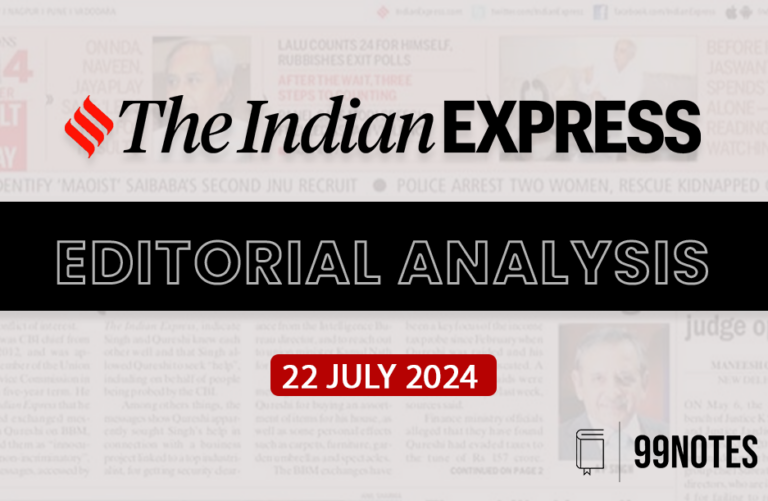7 March 2024 : Indian Express Editorial Analysis
Indian Express Editorial Analysis
7-March-2024
1. The thin-fat Indian
| Topic: GS2 – Social Justice – Health This topic is relevant for both Prelims and Mains as this analysis delves into the complex interplay between undernutrition, obesity, and the burden of diseases like diabetes, offering a nuanced understanding of societal health issues. |
| Context: |
|
Legacy of Undernutrition in India:
- India grapples with a historical legacy of undernutrition, evident in comparisons with European populations.
- While Europeans experienced a significant increase in height over the last two centuries, Indians showed minimal growth.
- However, there’s a positive trend in the current generation, indicating improved nutrition.
- This transition from long-term deprivation to rapid development underscores the need for comprehensive nutritional strategies.
Early Life Undernutrition and Diabetes/Obesity:
- The juxtaposition of “obesity day” and “women’s day” highlights a critical link often overlooked: the impact of early life undernutrition on the emergence of diabetes and obesity.
- Neglecting the nutrition and health of young mothers over centuries has resulted in the intergenerational transmission of health challenges.
- Research suggests that addressing maternal nutrition and health during pregnancy can mitigate the risk of diabetes and obesity in offspring, emphasizing the importance of preventive measures over reactive interventions.
Understanding Diabetes and Obesity in India:
- The experiences of a doctor at BJ Medical College and Sassoon Hospital in Pune provide insights into the unique characteristics of diabetes among Indians.
- Despite lower obesity rates compared to Westerners, Indians exhibit a higher prevalence of diabetes at a younger age.
- Research conducted during the 1980s revealed a phenomenon termed “thin-fat” Indian, wherein Indians with lower BMI still exhibit metabolic markers associated with obesity.
- This discovery led to the recognition of central obesity and its role in insulin resistance among Indians.
Intrauterine Programming and Epigenetics:
- Collaboration with experts shed light on the concept of intrauterine programming, wherein malnutrition during fetal development alters organ structure and function, predisposing individuals to metabolic disorders later in life.
- Studies on Indian newborns revealed a higher fat percentage despite lower birth weights, indicating the influence of intrauterine conditions on future health outcomes.
- The concept of epigenetics underscores the role of adverse intrauterine experiences in shaping disease risk, offering avenues for intervention through maternal health and nutrition initiatives.
Investing in Maternal Health and Future Generations:
- Recognizing the multifaceted impact of maternal health on future generations, national policies targeting adolescent girls and women of reproductive age aim to improve maternal nutrition and metabolic health.
- The “Developmental Origins of Health and Disease” framework underscores India’s significant contributions to understanding early-life determinants of health.
- By prioritizing investments in maternal health, India can foster resilience among future generations, mitigating the burden of obesity and diabetes.
Conclusion:
- India faces a dual challenge of undernutrition and the emergence of diabetes and obesity, rooted in historical legacies and intrauterine experiences.
- Addressing these challenges requires a multifaceted approach that prioritizes maternal health, nutrition, and metabolic well-being.
- By investing in preventive strategies and understanding the developmental origins of health and disease, India can pave the way for healthier future generations, shifting from reactive healthcare to proactive interventions.
| What are Overweight, Thinness, and Obesity? |
Body Mass Index:
Obesity and Overweight:
Thinness and Underweight:
|
| PYQ: Which of the following is/are the indicators/ indicators used by IFPRI to compute the Global Hunger Index Report? (2016) 1) Undernourishment 2) Child stunting 3) Child mortality Select the correct answer using the code given below: (a) 1 only (b) 2 and 3 only (c) 1, 2 and 3 (d) 1 and 3 only Ans: (c) |
| Practice Question: Discuss the intricate relationship between early-life undernutrition, obesity, and the emergence of diabetes, with specific reference to India’s unique socio-economic context. How can interventions targeting maternal health and nutrition mitigate the burden of these diseases in future generations? Explain with reference to recent research findings and their implications for public health policies. (250 words/15 m) |
2. An antidote called empathy
| Topic: GS1 – Society – Role of women and women’s organization GS4 – Attitude – Its influence and relation with thought and behaviour This topic is relevant for both Prelims and Mains as this article delves into the complexities surrounding Women’s Day celebrations, highlighting the discrepancy between public gestures of respect for women and underlying societal attitudes. |
| Context: |
|
A Call for Genuine Feminization:
- Amidst the cynicism surrounding Women’s Day celebrations, there arises a call to shed the facade and earnestly ponder the means to credibly feminize Indian institutions.
- This entails moving beyond mere tokenism, counting the number of women in power, or valorizing those who have achieved recognition.
- Rather, it necessitates rescuing institutions from the language of power and glory and transitioning towards a paradigm of care and empathy.
Challenges in Institutional Culture:
- The entrenched masculine culture within key institutions poses a significant obstacle to feminization efforts.
- Traits like competitiveness and assertiveness are often prioritized, perpetuating a culture of dominance.
- Mere representation of women in decision-making roles is insufficient; instead, emphasis should be on promoting diversity of experiences, emotional literacy, and privilege-checking among decision-makers.
Recognizing Recognition Gaps:
- Sociological insights, particularly from scholars like Michele Lamont, highlight the concept of recognition gaps, wherein certain social groups face disparities in worth and cultural membership.
- Institutions must serve as buffers to provide recognition to stigmatized groups, emphasizing affirmative action that prioritizes historically marginalized communities.
Transforming Mindsets and Values:
- Addressing the mindset of scarcity and dominance ingrained from childhood is crucial for fostering empathy and inclusivity among future generations.
- Education systems must promote understanding and recognition of diverse experiences, challenging existing biases and narrow worldviews.
Valuing Care Work:
- A feminized society acknowledges and values the labor of care, moving away from self-centeredness towards collective well-being.
- Policies should prioritize investing in the care economy, adequately compensating care workers, and mitigating the trade-offs women face between caregiving and career advancement.
Ensuring Safety Nets and Social Security:
- Safety nets and social security measures are imperative for ensuring the well-being of all individuals, irrespective of gender.
- A feminized society prioritizes the establishment of universal systems of economic assurance and risk insurance, addressing the vulnerabilities faced by marginalized communities.
Conclusion:
- Addressing the crisis of Indian masculinity requires embracing feminist principles that prioritize empathy and care over aggression and competition.
- A feminized India liberates the discourse on equality from tokenism and power dynamics, fostering a culture of genuine empathy and inclusivity.
| What are the Key Points about International Women’s Day? |
| About: It is celebrated annually on 8th March. It includes:
Brief History:
Theme in 2024:
|
| PYQ: What are the continued challenges for women in India against time and space? (250 words/15m) (UPSC CSE (M) GS-1 2019) |
| Practice Question: Discuss the challenges and opportunities in feminizing Indian institutions. How can policies and societal attitudes be transformed to promote genuine gender inclusivity and address systemic barriers faced by women in decision-making roles? (250 words/15 m) |
For Enquiry

7 March 2024 : Indian Express Editorial Analysis

6 Mar 2024 : Daily Current Affairs Quiz

6 Mar 2024 : Daily Answer Writing

6 March 2024 : The Hindu Editorial Notes PDF

6 March 2024 : PIB Summary for UPSC

6 March 2024 : Daily Current Affairs

6 March 2024 : Indian Express Editorial Analysis

5 Mar 2024 : Daily Current Affairs Quiz

4 Mar 2024 : Daily Current Affairs Quiz

5 Mar 2024 : Daily Answer Writing
Indian Express 7 March 2024 : Indian Express Editorial Analysis Indian Express Editorial Analysis
7-March-2024
1. The thin-fat Indian
Topic: GS2 – Social Justice…
Daily Quiz 6 Mar 2024 : Daily Current Affairs Quiz 6 Mar 2024 : Daily Quiz…
mains answer writing 6 Mar 2024 : Daily Answer Writing Mains Answer Writing
6-March-2024
Q1) The Finance Commission serves as the balancing wheel of fiscal…
March – The Hindu Editorial 6 March 2024 : The Hindu Editorial Notes PDF The Hindu Editorial
6-March-2024
1. Green jobs and the problem of gender disparity
Topic: GS3 –…
March 2024 PIB 6 March 2024 : PIB Summary for UPSC PIB Summary for UPSC
6-March -2024
1. India targets five-fold increase in its share of the global space…
Daily Current Affairs 6 March 2024 : Daily Current Affairs Daily Current Affairs
6-March -2024- Top News of the Day
1. Bombay High Court Acquits G N Saibaba: Emphasizes…
Indian Express 6 March 2024 : Indian Express Editorial Analysis Indian Express Editorial Analysis
6-March-2024
1. For the Gaya Lals of today
Topic: GS2 – Polity…
Daily Quiz 5 Mar 2024 : Daily Current Affairs Quiz 5 Mar 2024 : Daily Quiz…
Daily Quiz 4 Mar 2024 : Daily Current Affairs Quiz 4 Mar 2024 : Daily Quiz…
mains answer writing 5 Mar 2024 : Daily Answer Writing Mains Answer Writing
5-March-2024
Q1) Examine the mandate and powers of the National Commission for…




